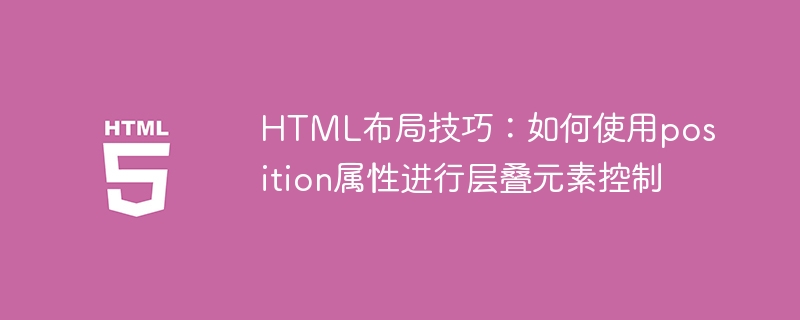 Web Front-end
Web Front-end
 HTML Tutorial
HTML Tutorial
 HTML layout tips: How to use the position attribute to control cascading elements
HTML layout tips: How to use the position attribute to control cascading elements
HTML layout tips: How to use the position attribute to control cascading elements

HTML layout skills: How to use the position attribute to control cascading elements
In web design, in order to achieve complex layout effects, we often need to use the position attribute to control The position and stacking relationship of elements. This article will introduce three commonly used position attribute values, namely relative, absolute and fixed, and give corresponding code examples.
1. Relative (relative positioning)
Relative positioning is to move the element relative to its original position without breaking away from the document flow.
Code example:
<style>
.relativeBox {
position: relative;
left: 100px;
top: 50px;
}
</style>
<div class="relativeBox">相对定位元素</div>In the above code, we set the position attribute to relative, and then use the left and top attributes to control the offset of the element relative to its original position. This way, the element will move 100px to the right and 50px down.
2. Absolute (absolute positioning)
Absolute positioning is positioned relative to the nearest positioned parent element (with a non-static position attribute set). If the positioned parent element cannot be found, is positioned relative to the browser window.
Code example:
<style>
.parentBox {
position: relative;
width: 300px;
height: 200px;
border: 1px solid #000;
}
.absoluteBox {
position: absolute;
left: 50px;
top: 50px;
}
</style>
<div class="parentBox">
<div class="absoluteBox">绝对定位元素</div>
</div>In the above code, we create a parent container parentBox, set its position attribute to relative, and then create a child element absoluteBox inside the container. By setting the position property of absoluteBox to absolute, and using the left and top properties to control its offset relative to the parent container. This way, the absoluteBox will be moved 50px to the right and down relative to the parentBox.
3. Fixed (fixed positioning)
Fixed positioning is positioned relative to the browser window and has nothing to do with scrolling. The element will always be fixed at the specified position.
Code example:
<style>
.fixedBox {
position: fixed;
right: 0;
bottom: 0;
width: 200px;
height: 150px;
}
</style>
<div class="fixedBox">固定定位元素</div>In the above code, we set the position attribute to fixed, and then use the right and bottom attributes to control the distance between the element and the lower right corner of the browser window. This way, the fixedBox will be fixed at the lower right corner of the browser window.
Through the use of the above three position attributes, we can easily achieve complex layout effects. It should be noted that you should be careful when using the position attribute and try to avoid overuse to avoid adversely affecting the performance of the web page. I hope this article can help readers better master the skills of using the position attribute to control cascading elements.
The above is the detailed content of HTML layout tips: How to use the position attribute to control cascading elements. For more information, please follow other related articles on the PHP Chinese website!

Hot AI Tools

Undresser.AI Undress
AI-powered app for creating realistic nude photos

AI Clothes Remover
Online AI tool for removing clothes from photos.

Undress AI Tool
Undress images for free

Clothoff.io
AI clothes remover

Video Face Swap
Swap faces in any video effortlessly with our completely free AI face swap tool!

Hot Article

Hot Tools

Notepad++7.3.1
Easy-to-use and free code editor

SublimeText3 Chinese version
Chinese version, very easy to use

Zend Studio 13.0.1
Powerful PHP integrated development environment

Dreamweaver CS6
Visual web development tools

SublimeText3 Mac version
God-level code editing software (SublimeText3)

Hot Topics
 1386
1386
 52
52
 Table Border in HTML
Sep 04, 2024 pm 04:49 PM
Table Border in HTML
Sep 04, 2024 pm 04:49 PM
Guide to Table Border in HTML. Here we discuss multiple ways for defining table-border with examples of the Table Border in HTML.
 HTML margin-left
Sep 04, 2024 pm 04:48 PM
HTML margin-left
Sep 04, 2024 pm 04:48 PM
Guide to HTML margin-left. Here we discuss a brief overview on HTML margin-left and its Examples along with its Code Implementation.
 Nested Table in HTML
Sep 04, 2024 pm 04:49 PM
Nested Table in HTML
Sep 04, 2024 pm 04:49 PM
This is a guide to Nested Table in HTML. Here we discuss how to create a table within the table along with the respective examples.
 HTML Table Layout
Sep 04, 2024 pm 04:54 PM
HTML Table Layout
Sep 04, 2024 pm 04:54 PM
Guide to HTML Table Layout. Here we discuss the Values of HTML Table Layout along with the examples and outputs n detail.
 HTML Input Placeholder
Sep 04, 2024 pm 04:54 PM
HTML Input Placeholder
Sep 04, 2024 pm 04:54 PM
Guide to HTML Input Placeholder. Here we discuss the Examples of HTML Input Placeholder along with the codes and outputs.
 HTML Ordered List
Sep 04, 2024 pm 04:43 PM
HTML Ordered List
Sep 04, 2024 pm 04:43 PM
Guide to the HTML Ordered List. Here we also discuss introduction of HTML Ordered list and types along with their example respectively
 Moving Text in HTML
Sep 04, 2024 pm 04:45 PM
Moving Text in HTML
Sep 04, 2024 pm 04:45 PM
Guide to Moving Text in HTML. Here we discuss an introduction, how marquee tag work with syntax and examples to implement.
 HTML onclick Button
Sep 04, 2024 pm 04:49 PM
HTML onclick Button
Sep 04, 2024 pm 04:49 PM
Guide to HTML onclick Button. Here we discuss their introduction, working, examples and onclick Event in various events respectively.



